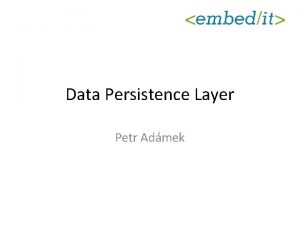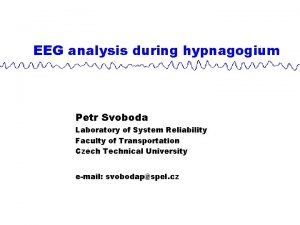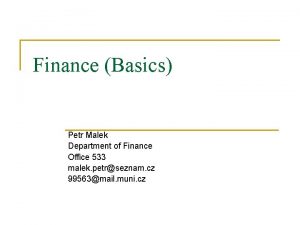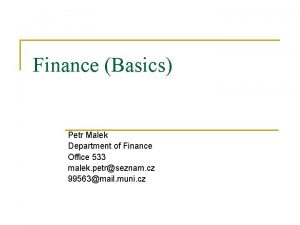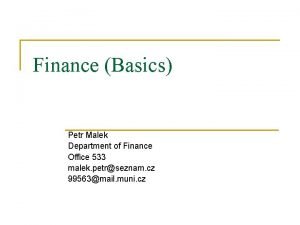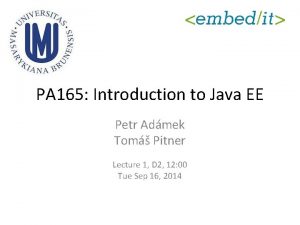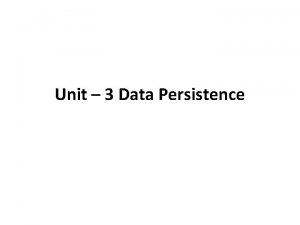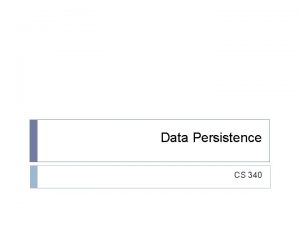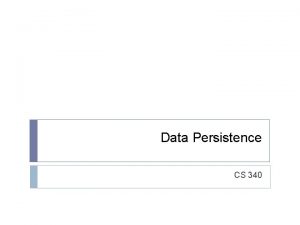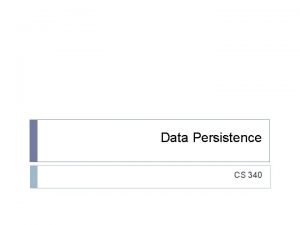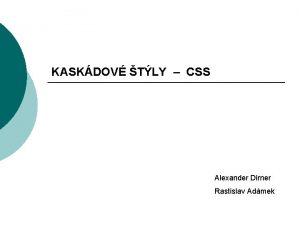Data Persistence Layer Petr Admek Content Persistence I

























































- Slides: 57

Data Persistence Layer Petr Adámek

Content: Persistence I. • Introduction to data persistence – Where to store data – How to work with data (Persistence technologies in Java EE) – Architecture of data persistence layer • Introduction to ORM – What is ORM – Basic Principles • JPA – – Introduction Entities in JPA Components Entity Lifecycle Data Persistence 2

Content: Persistence II • JPA – Advanced Mapping – Querying • JPQL • Criteria API • Alternatives – – – EJB 2. x JDO JDBC Embedded SQL Spring JDBC i. Batis • Best practices Data Persistence 3

INTRODUCTION INTO DATA PERSISTENCE LAYER Data Persistence 4

Where to store data Data can be stored on different places – – – Relational Database (RDBMS) Object Database XML Database DMS (Document Management System) CMS (Content Management System) Post-relational database (Caché) • • • Temporary Hierarchical Spatial – Key/Value (No-SQL) Database – Another Information System (CRM, ERP, etc. ) Data Persistence 5

Relational Databases • The most frequent data storage for enterprise applications Relational data model is simple but very powerful Suitable and sufficient for most of common applications Good theoretical model (Relational Algebra, Relational Calculus) Simplicity => High Performance (eg. due simple optimizations) Proven and well established technology (40 years of development, tools, standards, reliability, high penetration, lots of experts, etc. ) – Data are separated from application and can be easily shared between different applications – Independent on concrete platform or programming language – – – Data Persistence 6

Persistence Technologies • With Relational Model – – – JDBC (low-level API, cumbersome for direct use) Commons DB Utils Spring JDBC i. Batis/My. Batis Embedded SQL • With Object Model (ORM or other model conversion) – – Legacy EJB 2. x Hibernate JPA JDO Data Persistence 7

Architecture of persistence layer Presentation Tier DTO Business Logic Entity Persistence/DAO Tier JDBC / SQL DB Data Persistence 8

Architecture of persistence layer • DAO (Data Access Object) design pattern – Separation persistence and data access from business logic – Allows to modify persistence implementation or replace persistence technology at all without affecting application logic. • DTO (Data Transfer Object) design pattern – Business logic API is independent of entities – Data model can be changed without affecting Business logic API and/or presentation tier – DTO granularity is independent on entity size (single DTO could contain only subset of entity attributes or could agregate information from mulitple entities) Data Persistence 9

Transaction management • Transaction are not controlled on DAO level • Why? – Single transaction can contain more operations provided by different DAO components – Transaction management should be independent on persistent technology • Transaction management will be discussed later Data Persistence 10

INTRODUCTION TO ORM Data Persistence 11

What is ORM Object-relational mapping (ORM) – Technique for automatic conversion between object model and relational data model – You work with objects, but they are stored in a traditional relational database. INSERT INTO people (id, name) VALUES (1, "Pepa"); Person p = new Person(1, "Pepa"); em. persist(p); em. get. Transaction(). commit(); UPDATE people SET name = "Honza" WHERE id = 2; Person p = em. find(Person. class, 2); p. set. Name("Honza"); em. get. Transaction(). commit(); Data Persistence 12

Why ORM • As we already discussed, the most frequent storage is RDBMS • But we usually want to work with Object Model • Why Object Model? – It is natural for object oriented programming language – Working with Object Data Model is straightforward, friendly and easy – See example Data Persistence 13

Why ORM: JDBC example public String get. Person. Name(long person. Id) throws SQLException { Prepared. Statement st = null; try { st = connection. prepare. Statement( "SELECT name FROM people WHERE id = ? "); st. set. Long(1, person. Id); Result. Set rs = st. execute. Query(); if (rs. next()) { String result = rs. get. String("name"); assert !rs. next(); return result; } else { return null; } } finally { if (st != null) { st. close(); } } } Data Persistence 14

Why ORM: JPA Example public String get. Person. Name(long person. Id) { Person p = em. find(Person. class, person. Id); return p. get. Name(); } Data Persistence 15

ORM: What We Get and Lost • ORM Benefits – – – – Possibility to work with natural object model Portability between different RDBMS with different SQL Dialect Type checking at compile phase No runtime error in SQL statements Simplifies testing Simpler and clearer code More effective development (auto complete, access to Java. Doc, etc. ) • ORM drawbacks – Less control over SQL statements sent to database – Less performance in some cases (ORM has some overhead). – No access to advantages of relational model and features of RDBMS (e. g. storage procedures) Data Persistence 16

Basic terms What we should already know – JDBC, SQL, Transaction New terms – Entity – domain object representing data stored into database (eg. Person, Invoice, Course). – DTO (Data Transfer Object) – object for data encapsulation and transfering between components. – POJO (Plain Old Java Object) – simple class without any special requirements. It may not implement any special interface, it may not extend any given class, it may not dependent on any other class, package or framework. Data Persistence 17

Standards and Approaches Entity EJB (EJB 2. 1/JSR 153; J 2 EE 1. 4) – Application server with EJB container required. – Entity is heavyweight component, instances are located in EJB container and accessed through remote calls – Problem with latences (reason for introducing DTO and DAO patterns). – CMP or BMP – JPA is preferred since EJB 3. 0 JDO (JDO 3. 0/JSR 243) – General and universal standard for data persistence in Java. – Not limited to RDBMS, arbitrary storage can be used for storing objects JPA (JPA 2. 0/JSR 317; Java EE 6) – Java EE standard for ORM (inspired with Hibernate) – Entity is lightweight POJO which can be freely passed between components, locally or remotely. Data Persistence 18

EJB 2. x CMP Entity public abstract class Person. Bean implements Entity. Bean { private Entity. Context context; public abstract Long get. Id(); void set. Id(Long id); String get. Name(); void set. Name(String name); public Long ejb. Create (Long id, String name) throws Create. Exception { set. Id(id); set. Name(name); return id; } public void ejb. Post. Create (Long id, String name) throws Create. Exception {} public void set. Entity. Context(Entity. Context ctx) { context = ctx; } public void unset. Entity. Context() { context = null; } public public } void void ejb. Remove() {} ejb. Load() {} ejb. Store() {} ejb. Passivate() {} ejb. Activate() {} public Person. DTO get. Person. DTO() { return new Person. DTO(get. Id(), get. Name()); } Data Persistence 19

POJO Entity public class Person { private Long id; private String name; public Long get. Id() void set. Id(Long id) String get. Name() void set. Name(String name) { { return id; } this. id = id; } return name; } this. name = name; } public if if if } } boolean equals(Object o) { (this == o) { return true; } (get. Id() == null) { return false; } (o instanceof Person) { return get. Id(). equals(((Person) o). get. Id()); } else { return false; } public int hash. Code() { return id==null? 0: id. hash. Code(); } Data Persistence 20

Mapping Definition With annotations – Object model definition and its mapping are on the same place. – Clear and straightforward – Easier development and maintenance With external file (usualy XML) – Entities are independant on particular ORM technology – Mapping could be changed without modification of code With special Java. Doc comments – For Java 1. 4 and older (without annotations support) – See XDoclet. Data Persistence 21

Mapping and DB schema definition Generování schématu databáze na základě definice mapování – Máme vytvořené entity a definici mapování a chceme si ušetřit práci s vytvářením schématu databáze. – Je možné automaticky vytvářet tabulky při prvním spuštění aplikace. – Výhodné zejména při vývoji, kdy dochází ke změnám datového modelu. – Vhodné, pokud je datový model zcela pod kontrolou naší aplikace. – Problém, pokud se mění datový model a již máme v databázi existující data. Generování entit a definice mapování na základě schématu databáze – Máme vytvořené schéma databáze a chceme si ušetřit práci s vytvářením entit a definicí mapování (např. vyvíjíme aplikaci pro přístup k již existujícím datům). – Obvykle je nutné vygenerované soubory ručně opravit. Data Persistence 22

JAVA PERSISTENCE API Data Persistence 23

JPA Introduction Java Persistence API – POJO Entities, inspired by ORM tool Hibernate – API implemented by various ORM tools from different vendors. – Just basic functionality, implementations could provide other features and functions through its proprietary API Versions and specifications – JPA 1. 0 – part of Java EE 5; created as part of EJB 3. 0 (JSR 220), but independent. – JPA 2. 0 – součást Java EE 6; JSR 317 – JPA 2. 1 – part of Java EE 7; JSR 338 ORM tools implementing JPA – Hibernate, Open JPA – Top. Link, Top. Link Essentials, Eclipse Link Data Persistence 24

Entity in JPA Entity – – – Represent domain object Simple POJO class Attributes represents domain object properties Attributes accessible with set/get methods Mandatory parameterless constructor It is useful (but not mandatory) to implement Serializable Mapping definition – With annotations or xml file – Convention-over-configuration principle. Data Persistence 25

JPA Entity @Entity public class Person { @Id @Generated. Value(strategy = Generation. Type. AUTO) private Long id; private String name; public Long get. Id() void set. Id(Long id) String get. Name() void set. Name(String name) { { return id; } this. id = id; } return name; } this. name = name; } public if if if } } boolean equals(Object o) { (this == o) { return true; } (get. Id() == null) { return false; } (o instanceof Person) { return get. Id(). equals(((Person) o). get. Id()); } else { return false; } public int hash. Code() { return id==null? 0: id. hash. Code(); } Data Persistence 26

Example • Working With Entity Data Persistence 27

Configuration – Stored in persistence. xml – Contains one or more Persistence Units. Persistence Unit – List of classes managed by given Persistence Unit – Database connection configuration • JNDI name of Data. Source • JDBC url, name, password – Transaction control configuration (RESOURCE_LOCAL or JTA) – Table creation strategy Configuration parameter names – Vendor specific for JPA 1. 0, standardized for JPA 2. 0 – Parameters could be also set when creating Entity. Manager. Factory or Entity. Manager Data Persistence 28

JPA Architecture Instance of entity A Instance entity B Instance entity C Entity instances management Transaction 0. . 1 1 Persistence. Context Class of entity A Třída entity B Třída entity C Configuration, mapping definition 0. . n 1 1 Manages Configures 1. . n Entity. Manager Allows manipulation with entities Data Persistence. Unit 29 1 1 0. . n 1 Entity. Manager. Factory Reads PU Configuration Creates Entity. Manager

Entity Lifecycle em. detach(e) em. clear() Serialization and deserialization Persistence Context Expiration (eg. due em. close() operation) § Clone or copy § § Does not exist Entity e = new Entity(); New em. persist(e); Leaving Persistence Context Detached em. remove(e) Managed em. merge(e) All changes are automatically stored into DB when current transaction is commited Data Persistence 30 Deleted em. persist(e); em. refresh(e);

Quiz • Entity Lifecycle Data Persistence 31

MAPPING DEFINITION Data Persistence 33

Supported types • Primitive types: byte, int, short, long, boolean, char, float, double • Wrapper types: Byte, Integer, Short, Long, Boolean, Character, Float, Double • Byte and character array types: byte[], Byte[], char[], Character[] • Large numeric types: java. math. Big. Integer, java. math. Big. Decimal • Strings: java. lang. String • Java a JDBC temporal types: java. util. Date, java. util. Calendar, java. sql. Date, java. sql. Timestamp • Enumerated types: Any system or user-defined enumerated type • Serializable objects: Any system or user-defined serializable type • Any object with appropriate convertor (JPA 2. 1) Data Persistence 34

Field mapping configuration • Data Acces – Field access – Property access – Mixed access (@Access, JPA 2. 0) • • @Column @Basic @Lob @Transient or transient Data Persistence 35

Primary key • Supported types – – – byte, int, short, long, char Byte, Integer, Short, Long, Character, java. lang. String , java. math. Big. Integer java. util. Date, java. sql. Date Floating point types supported but strongly not recommended • ID generation – Sequence, identity, table, Auto • Composite primary key – Key class required Data Persistence 36

Field mapping • Data Acces – Field access – Property access – Mixed access (@Access, JPA 2. 0) • Enums • Temporal types (Date, Time) • Boolean Data Persistence 37

Relationships • Directionality – Uniderctional – Bidirectional • Cardinality – – One. To. Many. To. One Many. To. Many • Owning side – @Join. Column, mapped. By • Cascade Operations Data Persistence 38

Lazy fetching • @Basic, @One. To. One, @One. To. Many, @Many. To. One, @Many. To. Many • Useful, but use with care – Just performance hint, not necessary supported – Problem with detached entities – Not universal solution for dependency problem Data Persistence 39

Embedded object • @Embeddable, @Embedded • @Attribute. Overrides, @Attribute. Override • Multiple occurences of the same embedded class in the entity is not allowed in JPA 1. 0 Data Persistence 40

Element Collections • In addition to relationships, also collection of these objects are supported (since JPA 2. 0) – Simple types – Embeddable classes • @Element. Collection, @Collection. Table Data Persistence 41

Collection Types • Set, Collection – No aditional information required • List – @Order. By – @Order. Column (since JPA 2. 0) • Map – In JPA 1. 0, Map is allowed only in relationships (Value is entity and key is attribute of given entity) – In JPA 2. 0, any Simple. Type, Collection or Embeddable can be key or value – @Map. Key. Column, @Map. Key. Enumerated Data Persistence 42

Inheritance • @Mapped. Superclass • Entity inheritance – Single table strategy – Multiple table strategy – Join table strategy Data Persistence 43

QUERYING Data Persistence 44

Querying • JPQL – Query language similar to SQL – Supports scalar values, tuples, entities or constructed objects • Criteria API – From JPA 2. 0 – Allows to build query programatically • Native queries – Queries in SQL, non portable, not integrated with JPA infrastructure – Use only in exceptional cases Data Persistence 45

Calling JPQL Data Persistence 46

Example • JPQL – – – Executing simple query Named queries Returning scalar values Returning tuples Constructing objects • Criteria API – Simple example Data Persistence 47

JPQL Examples Data Persistence 48

OTHER TECHNOLOGIES Data Persistence 49

EJB 2. x • Incompatible with DAO Design Pattern – Actually, DAO Pattern was designed as replacement for EJB 2. x Entities • Requires Java EE Application server with EJB Container • Entity is heavyweight component, instances are located in EJB Container and accessed remotely • Problem with latencies (reason for introducing DAO and DTO design patterns) • CMP versus BMP • JPA is preferred from EJB 3. 0 Data Persistence 50

EJB 2. x Entity public abstract class Person. Bean implements Entity. Bean { private Entity. Context context; public abstract Long get. Id(); void set. Id(Long id); String get. Name(); void set. Name(String name); public Long ejb. Create (Long id, String name) throws Create. Exception { set. Id(id); set. Name(name); return id; } public void ejb. Post. Create (Long id, String name) throws Create. Exception {} public void set. Entity. Context(Entity. Context ctx) { context = ctx; } public void unset. Entity. Context() { context = null; } public public } void void ejb. Remove() {} ejb. Load() {} ejb. Store() {} ejb. Passivate() {} ejb. Activate() {} public Person. DTO get. Person. DTO() { return new Person. DTO(get. Id(), get. Name()); } Data Persistence 51

Embedded SQL • SQL written directly in the code • Code is processed with special preprocessor before compiling • Preprocessor process SQL expressions, checks their validity, performs type checking a translates them into expression of used programming language. • Preprocessor requires database connection public String get. Person. Name(long person. Id) { String name; #sql { SELECT name INTO : name FROM people WHERE id = : person. Id }; return name; } Data Persistence 52

Spring JDBC • Spring library implementing Template Method design pattern • Cleaner code, faster development, easier maintenance • Unlike ORM or Embedded SQL does not solve the problem with errors in SQL expressions, that become apparent until runtime Jdbc. Template jdbc. Template = new Jdbc. Template(data. Source); public String get. Person. Name(long person. Id) { return jdbc. Template. query. For. Object( "SELECT name FROM people WHERE id = ? ", String. class, person. Id); } Data Persistence 53

Apache Commons DBUtils • Another library implementing Template Method design pattern. Query. Runner query. Runner = new Query. Runner(data. Source); Result. Set. Handler<String> string. Handler = new Scalar. Handler<String>(); public String get. Person. Name(long person. Id) { return query. Runner. query( "SELECT name FROM people WHERE id = ? ", string. Handler, person. Id); } Data Persistence 54

i. Batis/My. Batis • Originally Apache project, retired, currently developed as My. Batis • SQL Queries are separated from code – In XML file – In annotations (in new versions) • More powerful that simple libraries like Spring JDBC, more lightweight than ORM Data Persistence 55

TRANSACTION MANAGEMENT Data Persistence 56

Transactions • Rollback in JPA and persistence context • Transaction scoped Persistence Context Data Persistence 57

Questions ? Data Persistence 58
 Data persistence layer
Data persistence layer What is esp
What is esp Static content vs dynamic content
Static content vs dynamic content Pigmented layer and neural layer
Pigmented layer and neural layer Git layers
Git layers Secure socket layer and transport layer security
Secure socket layer and transport layer security Layer 6 presentation layer
Layer 6 presentation layer Secure socket layer and transport layer security
Secure socket layer and transport layer security Secure socket layer and transport layer security
Secure socket layer and transport layer security Secure socket layer and transport layer security
Secure socket layer and transport layer security Layer 2 e layer 3
Layer 2 e layer 3 Layer-by-layer assembly
Layer-by-layer assembly Layer 2 vs layer 3 bitstream
Layer 2 vs layer 3 bitstream Hive provides data warehousing layer to data over hadoop.
Hive provides data warehousing layer to data over hadoop. What is data persistence in android
What is data persistence in android Petr lucie a tma
Petr lucie a tma Stavitel petr
Stavitel petr Petr měl obdélník šířky 2 cm a neznámé délky
Petr měl obdélník šířky 2 cm a neznámé délky Petr a lucie rozbor
Petr a lucie rozbor Petr a lucie hlavní myšlenka
Petr a lucie hlavní myšlenka Petr skryja
Petr skryja Seznma
Seznma Petr dejmek
Petr dejmek Petr svoboda lab
Petr svoboda lab Petr lapukhov
Petr lapukhov Petr dejmek
Petr dejmek Petr veigend
Petr veigend Petr dokáže udělat celou práci sám za 6 hodin
Petr dokáže udělat celou práci sám za 6 hodin Petr porn
Petr porn Petr dejmek
Petr dejmek Koleso text
Koleso text Petr paukner
Petr paukner Tertiärstufe
Tertiärstufe Katalysy
Katalysy Výstavbový princip
Výstavbový princip Petr rikov
Petr rikov Petr vech
Petr vech Petr gapko
Petr gapko Petr vech
Petr vech Petr jahn
Petr jahn Radomír kokeš
Radomír kokeš Petr beck
Petr beck Petr kolenko
Petr kolenko Petr malek
Petr malek Petr malek
Petr malek Ikonodulství
Ikonodulství Petr kokaisl
Petr kokaisl Petr palas
Petr palas Petr skryja
Petr skryja Petr knecht
Petr knecht Petr vech
Petr vech Ssodcs
Ssodcs Petr kener
Petr kener Kentico headless cms
Kentico headless cms Frantk
Frantk Petr malek
Petr malek Escape from petr
Escape from petr Petr bernat
Petr bernat
